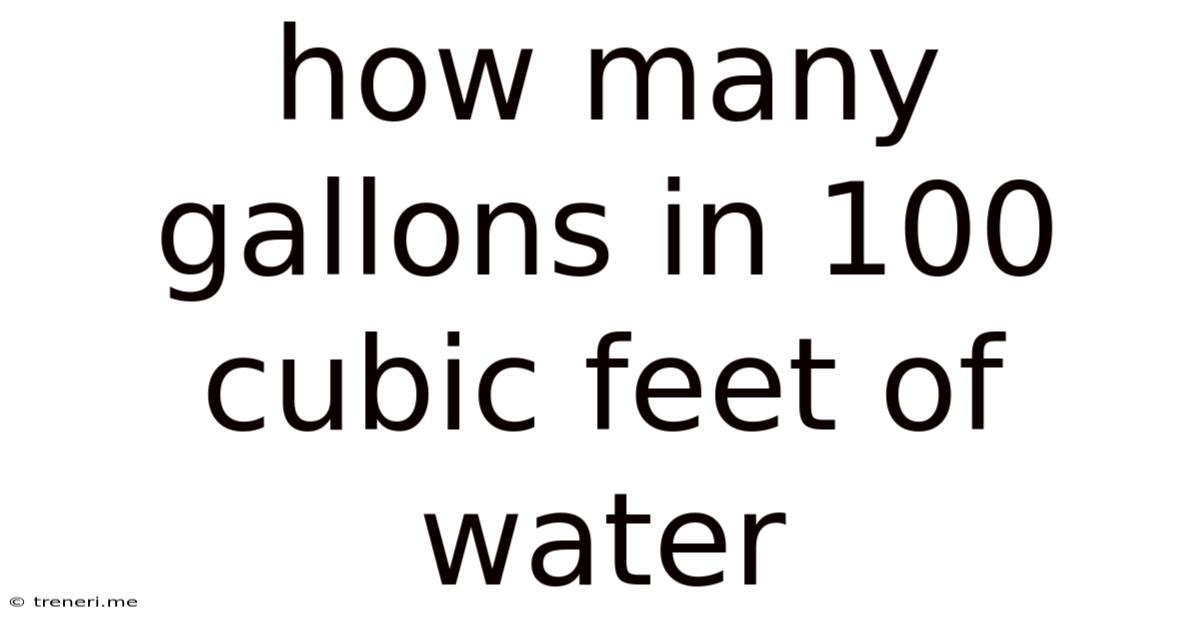How Many Gallons In 100 Cubic Feet Of Water
Treneri
May 12, 2025 · 4 min read

Table of Contents
How Many Gallons in 100 Cubic Feet of Water? A Comprehensive Guide
Knowing how to convert cubic feet to gallons is a crucial skill for various applications, from calculating water tank capacity to understanding irrigation needs. This comprehensive guide dives deep into the conversion process, explores real-world examples, and addresses common misconceptions to provide you with a complete understanding of the relationship between cubic feet and gallons of water.
Understanding Cubic Feet and Gallons
Before we delve into the conversion, let's clarify the units involved.
Cubic Feet (cu ft or ft³): This unit measures volume in three dimensions – length, width, and height. It represents the space occupied by a cube with sides measuring one foot each. Think of it as a box one foot long, one foot wide, and one foot high.
Gallons (gal): This is a unit of liquid volume. In the US, there are two main types: the US liquid gallon and the US dry gallon (although the dry gallon is rarely used). We will focus on the US liquid gallon, which is the standard for measuring liquids like water.
The Conversion Factor: Cubic Feet to Gallons
The key to converting cubic feet to gallons lies in understanding the conversion factor. One cubic foot of water contains approximately 7.48 US gallons. This is a crucial constant that forms the basis of all our calculations. Keep in mind that this is an approximation; the precise figure can vary slightly based on water temperature and pressure. However, 7.48 gallons per cubic foot is accurate enough for most practical purposes.
Calculating Gallons in 100 Cubic Feet
Now, let's tackle the central question: how many gallons are in 100 cubic feet of water? Using the conversion factor, the calculation is straightforward:
100 cubic feet * 7.48 gallons/cubic foot = 748 gallons
Therefore, there are approximately 748 gallons in 100 cubic feet of water.
Practical Applications and Real-World Examples
Understanding this conversion has numerous practical applications:
1. Water Tank Capacity
Imagine you're planning to install a water tank for your home or business. Knowing the tank's dimensions allows you to calculate its volume in cubic feet and then convert that volume to gallons to determine its water storage capacity. For example, a tank with dimensions of 5ft x 4ft x 5ft would have a volume of 100 cubic feet, which translates to approximately 748 gallons.
2. Swimming Pool Volume
Calculating the volume of a swimming pool often involves determining its cubic footage and then converting to gallons. This is crucial for tasks such as filling the pool, chemical treatment, and maintenance.
3. Irrigation System Design
For efficient irrigation, understanding water usage is vital. Knowing the volume of water needed in gallons allows you to design an appropriate irrigation system that delivers the right amount of water to your crops or lawn. Converting cubic feet to gallons facilitates this crucial step in irrigation system design.
4. Aquarium Capacity
Similar to swimming pools, calculating the volume of an aquarium in gallons is crucial for determining the number of fish it can support and the appropriate filtration system.
5. Rainwater Harvesting
Rainwater harvesting systems collect rainwater for various uses. Understanding the storage capacity of the collection tanks in gallons is crucial for effective rainwater management.
Beyond the Basics: Considering Water Density and Temperature
While the 7.48 gallons per cubic foot conversion factor is generally accurate, it's important to note that water density varies slightly with temperature and pressure. Colder water is slightly denser than warmer water. For most practical applications, this variation is negligible, but in highly precise scientific or engineering calculations, it should be considered.
Troubleshooting Common Conversion Mistakes
Here are some common mistakes to avoid when converting cubic feet to gallons:
-
Using the wrong conversion factor: Ensure you are using the correct conversion factor of 7.48 gallons per cubic foot for US liquid gallons. Using a different conversion factor will lead to incorrect results.
-
Incorrect unit calculations: Double-check your calculations for cubic feet. Make sure you correctly multiply the length, width, and height to determine the volume in cubic feet.
-
Forgetting the units: Always include the units (cubic feet and gallons) in your calculations to avoid confusion and errors.
-
Rounding errors: Be mindful of rounding errors, especially when dealing with large volumes.
Expanding your knowledge: Other Volume Conversions
Understanding cubic feet to gallons conversion is a foundational step. You can expand your knowledge by learning to convert other volume units, including:
-
Cubic meters to gallons: This is another important conversion, particularly in international contexts.
-
Liters to gallons: The liter is a common metric unit of volume.
-
Cubic yards to gallons: Larger-scale projects might require converting cubic yards to gallons.
Conclusion
Converting cubic feet to gallons is a valuable skill with wide-ranging applications. By understanding the conversion factor (7.48 gallons per cubic foot) and avoiding common mistakes, you can accurately calculate water volumes in various scenarios. Whether you're designing an irrigation system, calculating a water tank's capacity, or tackling any other task involving water volume, mastering this conversion will prove invaluable. Remember to always double-check your calculations and consider the potential influence of water density in high-precision applications.
Latest Posts
Latest Posts
-
Cuanto Son 150 Gramos En Tazas
May 12, 2025
-
I Was Born In 1998 How Old Am I
May 12, 2025
-
How To Do The Diamond Problems In Math
May 12, 2025
-
How Many Gallons Are In A Pond
May 12, 2025
-
Cuanto Es Una Yarda En Pies Cuadrados
May 12, 2025
Related Post
Thank you for visiting our website which covers about How Many Gallons In 100 Cubic Feet Of Water . We hope the information provided has been useful to you. Feel free to contact us if you have any questions or need further assistance. See you next time and don't miss to bookmark.